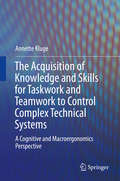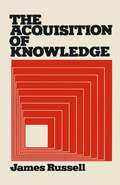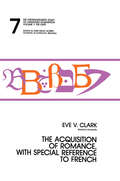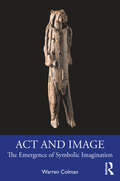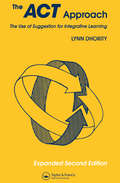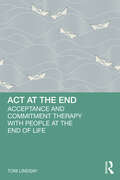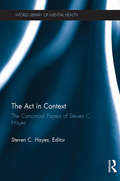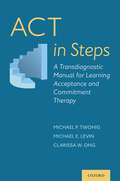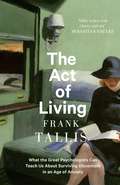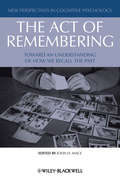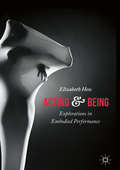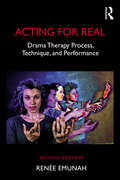- Table View
- List View
The Acquisition of Knowledge and Skills for Taskwork and Teamwork to Control Complex Technical Systems: A Cognitive and Macroergonomics Perspective
by Annette KlugeThis book provides the first comprehensive literature review on the acquisition and retention of complex skills in High Reliability Organizations. Based on this review, it introduces a theoretical model of how skill and knowledge acquisition for complex tasks is accomplished and shows how this model can be used to derive training methods and instructional techniques. Successful acquisition and retention of complex technical skills within High Reliability Organizations requires a full understanding of the learning process, knowledge structure, and skill requirements associated with the effective operation and management of technology. For researchers and for organizations, the understanding of these processes is vital for designing training programs as well as for reducing errors with severe consequences for human lives and the environment. Until now, only theoretical fragments exist on this topic, and only a very limited number of publications actually address complex tasks in vocational/occupational settings. “The Acquisition of Knowledge and Skills for Task Work and Teamwork to Control Complex Technical Systems ” uses its literature overview and theoretical model to formulate training principles, that can be used to develop training experiments for further empirical investigations as well as training methods for applied organizational contexts.
The Acquisition of Romance, With Special Reference To French: The Crosslinguistic Study of Language Acquisition, Volume 1, Chapter 7
by Eve ClarkFirst published in 1986. This edition offers a grammatical sketch of French, with occasional comments on how other Romance languages diverge from this picture; a brief account of the sources available on language acquisition by children; and a summary of the overall course of development in children acquiring the major Romance languages. The remainder of the review takes up different facets of the language acquisition process in more detail.
The Acquisition of Romance, With Special Reference To French: The Crosslinguistic Study of Language Acquisition, Volume 1, Chapter 7
by Eve ClarkFirst published in 1986. This edition offers a grammatical sketch of French, with occasional comments on how other Romance languages diverge from this picture; a brief account of the sources available on language acquisition by children; and a summary of the overall course of development in children acquiring the major Romance languages. The remainder of the review takes up different facets of the language acquisition process in more detail.
Act and Image: The Emergence of Symbolic Imagination
by Warren ColmanHow did humans develop the capacity for symbolic imagination? In this ground-breaking book, Warren Colman provides a reformulation of archetypal symbols as emergent from humans’ embodied and affective engagement with their social and material environment. Beginning with the oldest known figurative image in the world, the 40,000-year-old Lion Man of Hohlenstein-Stadel in Germany, he traces the emergence of symbolic imagination through the origins of language, the growth of human sociality and co-operation, and the creative use of material objects, from the earliest stone tools through the cave paintings and figures of Upper Paleolithic Europe and beyond. This leads to a consideration of how the imaginal world of the spirit may have come into being, not as separate from the material world but through active participation within a world alive with meaning.
Act and Image: The Emergence of Symbolic Imagination
by Warren ColmanHow did humans develop the capacity for symbolic imagination? In this ground-breaking book, Warren Colman provides a reformulation of archetypal symbols as emergent from humans’ embodied and affective engagement with their social and material environment. Beginning with the oldest known figurative image in the world, the 40,000-year-old Lion Man of Hohlenstein-Stadel in Germany, he traces the emergence of symbolic imagination through the origins of language, the growth of human sociality and co-operation, and the creative use of material objects, from the earliest stone tools through the cave paintings and figures of Upper Paleolithic Europe and beyond. This leads to a consideration of how the imaginal world of the spirit may have come into being, not as separate from the material world but through active participation within a world alive with meaning.
Act Approach:The Use of Suggestion for Intergrated Learning
by Lynn DhorityThis edition represents a thorough reworking, expansion and updating of an earlier work, distributed in manuscript from under the title Acquisition through Creative Teaching (ACT). This book is written for teachers, that is, for a wide range of professional communicators and facilitators of learning. It is designed as a practical guide for teachers who wish to learn how to use the art of suggestion to help students tap remarkable brain capacities.
Act Approach:The Use of Suggestion for Intergrated Learning
by Lynn DhorityThis edition represents a thorough reworking, expansion and updating of an earlier work, distributed in manuscript from under the title Acquisition through Creative Teaching (ACT). This book is written for teachers, that is, for a wide range of professional communicators and facilitators of learning. It is designed as a practical guide for teachers who wish to learn how to use the art of suggestion to help students tap remarkable brain capacities.
ACT Art Therapy: Creative Approaches to Acceptance and Commitment Therapy
by Amy BackosThere is nothing prescriptive about Acceptance and Commitment Therapy or Art Therapy. Both involve the client and the therapist cultivating creativity and psychological flexibility by letting go of limited, constricted, or habitual ways of thinking and being. This leads us to think, create, respond, and behave in ways of our choosing, bringing richness and renewed meaning to our lives.Through this work you will be able to apply ACT-informed art therapy to your practice. Art activities both illustrate the concepts and exist as stand-alone interventions to heighten creative potential and mindful attention to the present moment. ACT is effective when treating psychological difficulties such as depression, anxiety, OCD and psychosis. Readers will develop a meaningful context for understanding how ACT and art therapy align to creatively achieve positive outcomes for you and your clients.
ACT at the End: Acceptance and Commitment Therapy with People at the End of Life
by Toni LindsayACT at the End is based on the principles of Acceptance and Commitment Therapy (ACT), and while it has a grounding in research, it is also a hands-on clinical guide for those working with people at a tricky and complex time of life. This treatment manual is arranged to support clinicians in stepping through common concerns and addressing the ways that people at this stage of life may require psychological support as well as strategies for supporting clinicians working in this space. The guide provides a formulated ACT approach to address each element of the Hexaflex, as well as work around self-compassion and using ACT approaches to support difficult decision making.This book provides examples that clinicians will be able to apply to their own practices and tools that they can use to troubleshoot clinical concerns. It’s a helpful companion to clinicians navigating challenging terrain—much in the way that someone might turn to a colleague for advice, it is open and accessible, while still recognizing the ways in which that the work is hard.
ACT at the End: Acceptance and Commitment Therapy with People at the End of Life
by Toni LindsayACT at the End is based on the principles of Acceptance and Commitment Therapy (ACT), and while it has a grounding in research, it is also a hands-on clinical guide for those working with people at a tricky and complex time of life. This treatment manual is arranged to support clinicians in stepping through common concerns and addressing the ways that people at this stage of life may require psychological support as well as strategies for supporting clinicians working in this space. The guide provides a formulated ACT approach to address each element of the Hexaflex, as well as work around self-compassion and using ACT approaches to support difficult decision making.This book provides examples that clinicians will be able to apply to their own practices and tools that they can use to troubleshoot clinical concerns. It’s a helpful companion to clinicians navigating challenging terrain—much in the way that someone might turn to a colleague for advice, it is open and accessible, while still recognizing the ways in which that the work is hard.
ACT for Burnout: Recharge, Reconnect, and Transform Burnout with Acceptance and Commitment Therapy
by Debbie Sorensen"I know what it's like to care deeply about my work and yet feel utterly exhausted by it."Burnout is more widespread than ever before, and it's time to do something about it.Rooted in Acceptance and Commitment Therapy (ACT), this book delves into the systemic, cultural, and economic contexts that contribute to burnout, and gives you the tools to exit the cycle. Exercises and reflection questions help you reconnect with your values to find what's really important, and disentangle yourself from unhelpful thought patterns. By engaging with your emotions rather than avoiding or suppressing them, ACT allows you to respond more effectively and become re-engaged in your own life again. This book will show you how to move out of the burnout cycle, reconnect with meaningful aspects of your work, and make changes that last.
ACT for Gender Identity: The Comprehensive Guide
by Alex StittIncreasingly adopted by therapists and mental health professionals, Acceptance and Commitment Therapy (ACT) helps clients to cope with social, emotional and mental health issues by using the six core ACT processes: Acceptance, Cognitive Defusion, Being Present, the Self as Context, Values and Committed Action.This is the go-to-guide for evidence-based ACT techniques to be used by professionals to help their transgender, genderqueer, genderfluid, third gender and agender clients. It provides the tools to help these clients develop emotional processing skills they can implement throughout their life, from coping with mental health issues and substance abuse, to navigating prejudice and social pressure, to building a career and developing a family.
The Act in Context: The Canonical Papers of Steven C. Hayes (World Library of Mental Health)
by Steven C. HayesThe Canonical Papers of Steven C. Hayes is a compilation of his most pivotal articles written from 1982-2012. Through these selected papers, Hayes again revisits the theoretical struggles between behavioral and cognitive-behavior theories, taking us from the 1980s into present day, discussing the breakthroughs and follies. Using this as a focus point, he discusses the tradition of behavior analysis and its difficulties in addressing human language and cognition. Moving forward into the 90s, he chronicles the changes in a behavioral approach that emerge from a contextual perspective on human cognition, and lays out the foundation for a contextual behavioral science approach that he argues is more likely to lead to an understanding of human action and an alleviation of human suffering. Although the articles have previously been published, they have been edited and compiled ensure this branch of research is clear to the modern audience. The compilation was chosen by Dr. Hayes to enhance his vision for a functional contextual approach to complex human behavior.
The Act in Context: The Canonical Papers of Steven C. Hayes (World Library of Mental Health)
by Steven C. HayesThe Canonical Papers of Steven C. Hayes is a compilation of his most pivotal articles written from 1982-2012. Through these selected papers, Hayes again revisits the theoretical struggles between behavioral and cognitive-behavior theories, taking us from the 1980s into present day, discussing the breakthroughs and follies. Using this as a focus point, he discusses the tradition of behavior analysis and its difficulties in addressing human language and cognition. Moving forward into the 90s, he chronicles the changes in a behavioral approach that emerge from a contextual perspective on human cognition, and lays out the foundation for a contextual behavioral science approach that he argues is more likely to lead to an understanding of human action and an alleviation of human suffering. Although the articles have previously been published, they have been edited and compiled ensure this branch of research is clear to the modern audience. The compilation was chosen by Dr. Hayes to enhance his vision for a functional contextual approach to complex human behavior.
ACT in Steps: A Transdiagnostic Manual for Learning Acceptance and Commitment Therapy
by Michael P. Twohig Michael E. Levin Clarissa W. OngACT (acceptance and commitment therapy) can be applied to any psychological disorder that involves struggle with inner experiences. With over 300 randomized clinical trials supporting its effectiveness, ACT has seen rapid growth in popularity, and an increasing number of therapists are being trained in its use. As such, the demand for practical resources on providing ACT has never been greater. ACT in Steps is aimed at any therapist who wants to get familiar with ACT. Chapters walk therapists through a recommended sequence of ACT sessions, including creative hopelessness, control as the problem, acceptance, defusion, mindfulness, values, and committed action, and provide accompanying materials for clients. The book also provides information on assessment, case conceptualization, treatment planning, and intervention that therapists can use as a starting point for practicing ACT. Exercises and worksheets are included which will continue to be useful long after readers have achieved mastery of ACT. Designed to serve as a more structured framework from which therapists can learn and experiment with ACT concepts, ACT in Steps is suitable for anyone interested in applying ACT across a range of presentations, from graduate students seeing their first clients to clinicians with years of experience interested in learning about ACT for the first time.
ACT in Steps: A Transdiagnostic Manual for Learning Acceptance and Commitment Therapy
by Michael P. Twohig Michael E. Levin Clarissa W. OngACT (acceptance and commitment therapy) can be applied to any psychological disorder that involves struggle with inner experiences. With over 300 randomized clinical trials supporting its effectiveness, ACT has seen rapid growth in popularity, and an increasing number of therapists are being trained in its use. As such, the demand for practical resources on providing ACT has never been greater. ACT in Steps is aimed at any therapist who wants to get familiar with ACT. Chapters walk therapists through a recommended sequence of ACT sessions, including creative hopelessness, control as the problem, acceptance, defusion, mindfulness, values, and committed action, and provide accompanying materials for clients. The book also provides information on assessment, case conceptualization, treatment planning, and intervention that therapists can use as a starting point for practicing ACT. Exercises and worksheets are included which will continue to be useful long after readers have achieved mastery of ACT. Designed to serve as a more structured framework from which therapists can learn and experiment with ACT concepts, ACT in Steps is suitable for anyone interested in applying ACT across a range of presentations, from graduate students seeing their first clients to clinicians with years of experience interested in learning about ACT for the first time.
The Act of Living: What the Great Psychologists Can Teach Us About Surviving Discontent in an Age of Anxiety
by Frank Tallis'Tallis writes with clarity and wit' Sebastian FaulksScience, technology and western liberal democracy have all had a dramatic impact on our quality of life. Compared to previous generations, we have unprecedented access to information, increased personal freedom, more material comforts and more possessions. Yet, even before the shock of Covid-19, more people than ever before were reporting being depressed, anxious or unfulfilled. As our material circumstances become easier, life seems to get harder. Why should this be? Shelves sag under the weight of self-help manuals and the internet is awash with the advice of role-models and celebrity gurus; however, to what extent can these sources be expected to supply meaningful, practical answers - the kind of answers relevant to sceptical individuals living in a modern, technologically advanced culture? For over a hundred years, psychotherapists have been developing and refining models of the human mind. They have endeavoured to alleviate distress and they have offered help to people who want to make better life choices. Although the clinical provenance of psychotherapy is important, the legacy of psychotherapy has much wider relevance. It can offer original perspectives on the big questions usually entrusted to philosophers and representative of faith: Who am I? Why am I here? How should I live?In this compelling and important book, the principle contributions of the outstanding figures associated with the practice of psychotherapy are explained: from Freud to Ellis, Jung to Laing, Adler to Hayes. Viewed as a single, cohesive intellectual tradition, Frank Tallis argues that psychotherapeutic thinking is an immensely valuable and under exploited resource.
The Act of Remembering: Toward an Understanding of How We Recall the Past (New Perspectives in Cognitive Psychology #3)
by John H. MaceThe first volume devoted solely to autobiographical memory retrieval, The Act of Remembering serves as a primer of ideas, methodology, and central topics, and lays the groundwork for future research in the field. Contains new, forward-looking theories from leading international scholars Answers questions such as: Do we retrieve memories according to when and where we need them? How much conscious control do we have over what we remember? Why are some people more likely than others to have intrusive ‘flashbacks’ following a stressful event? Pays particular attention to voluntary and involuntary recall
The Act of Remembering: Toward an Understanding of How We Recall the Past
by John H. MaceThe first volume devoted solely to autobiographical memory retrieval, The Act of Remembering serves as a primer of ideas, methodology, and central topics, and lays the groundwork for future research in the field. Contains new, forward-looking theories from leading international scholars Answers questions such as: Do we retrieve memories according to when and where we need them? How much conscious control do we have over what we remember? Why are some people more likely than others to have intrusive ‘flashbacks’ following a stressful event? Pays particular attention to voluntary and involuntary recall
The ACT Workbook for Teens with OCD: Unhook Yourself and Live Life to the Full
by Patricia Zurita Psy.DThis workbook, based on Acceptance and Commitment Therapy (ACT) and Exposure Response Prevention (ERP), teaches teens with OCD new skills to handle the stream of pesky obsessions that show up in their mind.It presents the Choice Point - a tool to help teens choose how to handle those tricky moments when dealing with unwanted thoughts. Chapter by chapter, teens learn powerful skills to unhook from their obsessions, including exposure exercises and strategies for accepting their emotions, and complete activities to help them overcome their compulsions, avoidant behaviors, and requests for accommodations. With real-life examples and tons of fun activities, this workbook shows that fears, worry and nervousness are a part of life and gives teens the skills to choose how to respond to their obsessions and move towards the stuff they really care about. Making applying ACT and ERP skills fun, it encourages them to face their fears and live life to the full.
Acting and Being: Explorations in Embodied Performance
by Elizabeth HessIn this book, educator-actor-playwright-director Elizabeth Hess offers systematic and original explorations in performance technique. This hybrid approach is a fusion of physical theater modalities culled from Western practices (Psycho-physical actions, Viewpoints) Eastern practices (Butoh, Kundalini yoga) and related performance disciplines (Mask, Puppetry). Behavioral, physiological and psychological ‘states of being’ are engaged to unlock impulses, access experience and enlarge the imagination. Through individual, partnered and collective explorations, actors uncover a character’s essence and level of consciousness, their energy center and body language, and their archetype and relationship to universal themes. Magic (to pretend, as if), Metaphor (to compare, as like) and Myth (to pattern after, as in) provide the foundation for generating transformative, empathetic and expansive artistic expression. Explorations can be adapted to character work, scene study and production, including original/devised work and established text, to illuminate singular and surprising work through collaborative creativity that is inventive, inclusive and alive.
Acting Antics: A Theatrical Approach to Teaching Social Understanding to Kids and Teens with Asperger Syndrome (PDF)
by Cindy Schneider Tony Attwood`The ideas are excellent and well laid out… This is an innovative approach to social skills training for students with Asperger's Syndrome who will tolerate acting, and for a group leader with energy and commitment to drama.' -Speech and Language Therapy in Practice `Schneider's enthusiasm for the subject and her passion to improve life skills of young people is very evident and encourages the reader to progress…As a catalogue of practical ideas with built-in resources, this is a useful book for support groups and families wishing to create a theatre group. Acting Antics has an easy-to-read format and includes activities that can be initiated with minimum preparation and resources.' -Children Now Magazine, 2007 This fun and inspiring step-by-step program provides the full set of tools for developing social understanding in children with Asperger Syndrome (AS) through drama. Cindy B. Schneider explains how the central processes in acting - including making and interpreting inferences from non-verbal cues, taking another's perspective, and formulating language - can be highly effective ways of addressing social cognition deficits in children with AS. Acting Antics contains a wide repertoire of activities and ideas for immediate application at home, in the classroom, in therapy workshops or social groups, ranging from initial warm up techniques, through paired activities, to larger group scenes and staging a show. Helpful appendices provide questionnaire forms to enable both the child and the program leader to assess and monitor the child's understanding of their roles, along with reproducible scripts and suitable scene designs. This complete, practical program provides a wealth of enjoyable educational ideas for parents, teachers, and therapists of children with Asperger Syndrome.
Acting For Real: Drama Therapy Process, Technique, And Performance
by Renée EmunahThis second edition takes the reader further into the heart of using drama for healing. Dr. Emunah offers an expanded understanding of her Integrative Five Phase model, a foundational approach that embraces the wide spectrum of possibilities within the playing field of drama therapy. Grounded by compassionate clinical examples, including ones that reach over time into deep-seated issues, the book offers tools for action-oriented treatment, embodied therapeutic interventions, and creatively engaging a wide variety of clients. This comprehensive text also contains over 120 techniques, categorized by phases in the session and treatment series, and subcategorized by therapeutic objective. Process-oriented drama therapy with group and individuals, as well as performance-oriented forms, are described in vivid detail. New to the second edition is an exploration of drama therapy outside of the clinical arena, including dramatic methods in family life and parenting, and drama therapy geared toward social change.
Acting For Real: Drama Therapy Process, Technique, And Performance
by Renée EmunahThis second edition takes the reader further into the heart of using drama for healing. Dr. Emunah offers an expanded understanding of her Integrative Five Phase model, a foundational approach that embraces the wide spectrum of possibilities within the playing field of drama therapy. Grounded by compassionate clinical examples, including ones that reach over time into deep-seated issues, the book offers tools for action-oriented treatment, embodied therapeutic interventions, and creatively engaging a wide variety of clients. This comprehensive text also contains over 120 techniques, categorized by phases in the session and treatment series, and subcategorized by therapeutic objective. Process-oriented drama therapy with group and individuals, as well as performance-oriented forms, are described in vivid detail. New to the second edition is an exploration of drama therapy outside of the clinical arena, including dramatic methods in family life and parenting, and drama therapy geared toward social change.
